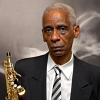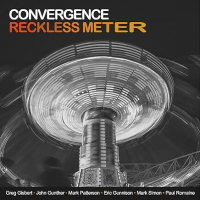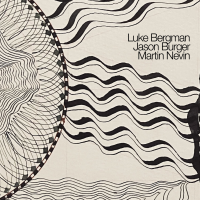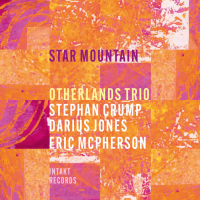Home » Jazz Articles » Album Review » Ivo Perelman: Reed Rapture in Brooklyn
Ivo Perelman: Reed Rapture in Brooklyn
Perelman's story is one of immersion in the creative process, one that begins in his native Brazil's folk music, where he studied classical guitar before turning to the saxophone. Moving to the United States, he briefly attended the Berklee College of Music before blazing his own path. His investigations led him to the music of Albert Ayler and late career explorations of John Coltrane. This conversion can be heard on Live (Zero In, 1997) a rough-hewed session with William Parker and {Rashied Ali}}. Fast forward a dozen years and his music has evolved into a unique and utterly distinctive sound. Eschewing written material and with no preplanning or discussion, he enters the recording studio to make spontaneous music. In half of the sessions, he is accompanied by the like-minded pianist Matthew Shipp, and Perelman can also be found in the company of string players such as Mat Maneri, Hank Roberts, and Mark Feldman or pianists as documented in the boxset Brass And Ivory Tales (Fundacja Słuchaj!, 2021).
With Reed Rapture in Brooklyn, he invites twelve reed musicians (various saxophones and clarinets) from different generations—Joe Lovano, Tim Berne, David Murray, Lotte Anker, James Carter, Vinny Golia, Jon Irabagon, Joe McPhee, Roscoe Mitchell, Colin Stetson, Dave Liebman and Ken Vandermark to record spontaneous duo music in the studio. Although each session could have been released as a stand-alone album, together they reveal just how distinctive the saxophonist's voice is.
Perelman's meeting with Joe Lovano, who is perhaps the most traditional of the players in this collection, results in fourteen relatively short performances. Joe, son of bebop legend Tony "Big T" Lovano in Cleveland, Ohio is currently an ECM Records artist. His sound today is eternally sweet-toned. If, though, one is to follow his career back to its early days and his work with Paul Motian and John Scofield, his connections to Perelman's freedom of sound are apparent. Lovano plays the C melody and soprano saxophones here, sprinkling in bebop phrases and bluesy riffs that balance Perelman's upper register explorations as Lovano kindles a rather romantic tone.
The alto saxophonist Tim Berne maintains an air of intransigency here, and Perelman is fine with it. Almost pleased. Berne, an avowed disciple of Henry Threadgill, has always forged his own path in music. Here his sound is pugnacious, prodding Perelman to scale the same upper register heights. This aggression ignites a radiance of sound that carries through even into the quieter passages.
The early careers of both Perelman and David Murray were almost interchangeable. Both found their footing in the music of Albert Ayler. Like Perelman this century, Murray's recording output was prolific and overflowing in the late 1980s and 90s. He was a founding member of the World Saxophone Quartet and has since become an elder statesman of jazz. Here he sets aside his tenor saxophone for a bass clarinet. The sounds alternate between moody and exuberant. Murray's sound mostly maintains the bottom with rousing post-Eric Dolphy flights inserted throughout.
Danish saxophonist Lotte Anker might be Perelman's doppelgänger. A master of multiple saxophones, including the tenor, she sticks to alto and soprano here. Maybe the reason being a desire not to replicate Perelman's tenor. The saxophonists engage in a continuous intertwining of sound, wrapping lines around lines. This creates frayed edges that are themselves crisscrossed and woven back into this dialogue.
Ken Vandermark, like Murray, is another tenor saxophonist that sets aside his main instrument for a clarinet. While also proficient with the larger bass clarinet, he sticks to the straight black stick here. His sound calls to mind the abstractions of Jimmy Giuffre. While Vandermark is an accomplished composer, arranger and bandleader, he is also a formidable free player. The twelve brief interactions between the players swap a call-and-response approach with the aggression of free association music, yielding to a satisfactory compromise.
Unlike all the music recorded in Brooklyn, Perelman traveled to Wisconsin to capture this duo with Roscoe Mitchell. The legendary saxophonist was a cofounder of both the Art Ensemble of Chicago and the Association for the Advancement of Creative Musicians (AACM). His early explorations in solo performance and his expansion of singular expression laid the foundation for the acceptance of Perelman's sound and career. Mitchell chose to stick with just one horn here, the bass saxophone, and his choice controls the affair. Perelman's usual rapid delivery is restricted by Mitchell's deliberate approach. The space opened up between players and between notes is in itself entrancing.
Outside of Anthony Braxton and Vinny Golia, James Carter might perform on the greatest variety saxophones. He is an omnivore of sound with far ranging interests. Here he limits himself to the baritone saxophone. Yet, boundaries are not possible for Carter. Even though the baritone elicits thoughts of the bottom end of sound, he follows Perelman into the upper registers when he is not playfully applying depths of his instrument. This pairing might be the most spirited and indeed, the most fun. Carter and Perelman gambol, romp and revel in this merrymaking.
If backyard baseball is a sport of fathers and sons, football is all about brothers. Ivo Perelman and Jon Irabagon play down after down of football in their encounter. Their seven tracks are an exploration of the limits and capabilities of the saxophone. Irabagon chooses two, the sopranino and slide soprano. These atypical saxophones make unconventional sounds and inspire both musicians to explore new and often dizzying heights. The strange and unusual blossoms into the beautiful here.
The calling card for Joe McPhee should read, "plays well with others." The octogenarian multi-instrumentalist has an immense discography performing with everyone from Evan Parker and Steve Lacy to the Cato Salsa Experience and The Thing. This might be his first encounter with Perelman, but they sound like friends reunited. McPhee sticks to tenor saxophone, which makes the music come off as a kind of gentle dance between horns. Perelman's upper register travels are encouraged by McPhee's low end. Elsewhere, McPhee engages in some vocalizations, alternating between horn and voice. This in turn draws out Perelman's vocal expressions.
Colin Stetson's contrabass saxophone sound is analogous to an eighteen-wheeler truck. It is big, no it is a huge rig. With it, the saxophonist has been creating fascinating soundscapes, oftentimes solo. He can conjure textures other musicians require a small cadre of partners and engineers to fabricate. Stetson brings these sounds into Perelman's orbit, generating thunderous reverberating tones, growls, clicks and pops. The gravity of Stetson inspires Perelman to both take flight in the upper registers of his tenor and mine its bottom.
The eternally underrated saxophonist Vinny Golia arrives at this session with the tiny soprillo saxophone, plus a clarinet and a basset horn, which is also in the clarinet family. Had this recording been near his West Coast home, he might have brought another thirty or so instruments. He prefers to rotate horns frequently, yet here Golia settles for changing approach. There are call-and-response passages, high intensity sprints, bluesy interludes, chirping birds, and the musical equivalent of haiku poems.
The encounter with Dave Liebman, who sticks with soprano saxophone, is the most structured of the meetings collected here. The saxophonist has an inherent way of organizing sounds, even in a purely improvised setting. That is not to say Liebman relies on a chestful of musical tropes, more like he is fluent in multiple languages and can switch comfortably into any vernacular he selects. New listeners to the world of Ivo Perelman might want to begin here as the eleven shortish tracks with Liebman are the most accessible.
Track Listing
Ivo - Lovano - 01; Ivo - Lovano - 02; Ivo - Lovano - 03; Ivo - Lovano - 04; Ivo - Lovano - 05; Ivo - Lovano - 06; Ivo - Lovano - 07; Ivo - Lovano - 08; Ivo - Lovano - 09; Ivo - Lovano - 10; Ivo - Lovano - 11; Ivo - Lovano - 12; Ivo - Lovano - 13; Ivo - Lovano - 14; Ivo - Berne - 01; Ivo - Berne - 02; Ivo - Berne - 03; Ivo - Berne - 04; Ivo - Berne - 05; Ivo - Murray - 01; Ivo - Murray - 02; Ivo - Murray - 03; Ivo - Murray - 04; Ivo - Murray - 05; Ivo - Murray - 06; Ivo - Murray - 07; Ivo - Murray - 08; Ivo - Murray - 09; Ivo - Murray - 10; Ivo - Anker - 01; Ivo - Anker - 02; Ivo - Anker - 03; Ivo - Anker - 04; Ivo - Anker - 05; Ivo - Anker - 06; Ivo - Anker - 07; Ivo - Anker - 08; Ivo - Vandermark - 01; Ivo - Vandermark - 02; Ivo - Vandermark - 03; Ivo - Vandermark - 04; Ivo - Vandermark - 05; Ivo - Vandermark - 06; Ivo - Vandermark - 07; Ivo - Vandermark - 08; Ivo - Vandermark - 09; Ivo - Vandermark - 10; Ivo - Vandermark - 11; Ivo - Vandermark - 12; Ivo - Mitchell - 01; Ivo - Mitchell - 02; Ivo - Mitchell - 03; Ivo - Carter- 01; Ivo - Carter- 02; Ivo - Carter- 03; Ivo - Carter- 04; Ivo - Carter - 05; Ivo - Carter - 06; Ivo - Carter - 07; Ivo - Carter - 08; Ivo - Carter - 09; Ivo - Irabagon - 01; Ivo - Irabagon - 02; Ivo - Irabagon - 03; Ivo - Irabagon - 04; Ivo - Irabagon - 05; Ivo - Irabagon - 06; Ivo - Irabagon - 07; Ivo - McPhee - 01; Ivo - McPhee - 02; Ivo - McPhee - 03; Ivo - McPhee - 04; Ivo - McPhee - 05; Ivo - McPhee - 06; Ivo - McPhee - 07; Ivo - Stetson - 01; Ivo - Stetson - 02; Ivo - Stetson - 03; Ivo - Stetson - 04; Ivo - Stetson - 05; Ivo - Stetson - 06; Ivo - Golia - 01; Ivo - Golia - 02; Ivo - Golia - 03; Ivo - Golia - 04; Ivo - Golia - 05; Ivo - Golia - 06; Ivo - Golia - 07; Ivo - Golia - 09; Ivo - Golia - 09; Ivo - Golia - 10; Ivo - Golia - 11; Ivo - Liebman - 01; Ivo - Liebman - 02; Ivo - Liebman - 03; Ivo - Liebman - 04; Ivo - Liebman - 05; Ivo - Liebman - 06; Ivo - Liebman - 07; Ivo - Liebman - 08; Ivo - Liebman - 09; Ivo - Liebman - 10; Ivo - Liebman - 11.
Personnel
Ivo Perelman
saxophone, tenorDavid Murray
saxophone, tenorJoe Lovano
drumsJames Carter
saxophoneTim Berne
saxophone, altoRoscoe Mitchell
saxophoneJoe McPhee
woodwindsVinny Golia
woodwindsJon Irabagon
saxophoneKen Vandermark
saxophoneColin Stetson
woodwindsLotte Anker
saxophoneAlbum information
Title: Reed Rapture in Brooklyn | Year Released: 2022 | Record Label: Mahakala Music
Tags
Parker Matthew Shipp Mat Maneri Hank Roberts Mark Feldman joe lovano Tim Berne David Murray Lotte Anker James Carter Vinny Golia Jon
Irabagon Joe McPhee Roscoe Mitchell Colin Stetson Dave Liebman Ken Vandermark Paul Motian John Scofield Henry Threadgill Eric Dolphy Jimmy Giuffre anthony braxton evan parker Steve Lacy
PREVIOUS / NEXT
Support All About Jazz
 All About Jazz has been a pillar of jazz since 1995, championing it as an art form and, more importantly, supporting the musicians who make it. Our enduring commitment has made "AAJ" one of the most culturally important websites of its kind, read by hundreds of thousands of fans, musicians and industry figures every month.
All About Jazz has been a pillar of jazz since 1995, championing it as an art form and, more importantly, supporting the musicians who make it. Our enduring commitment has made "AAJ" one of the most culturally important websites of its kind, read by hundreds of thousands of fans, musicians and industry figures every month.

































